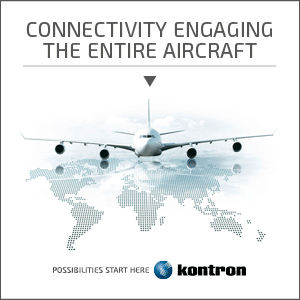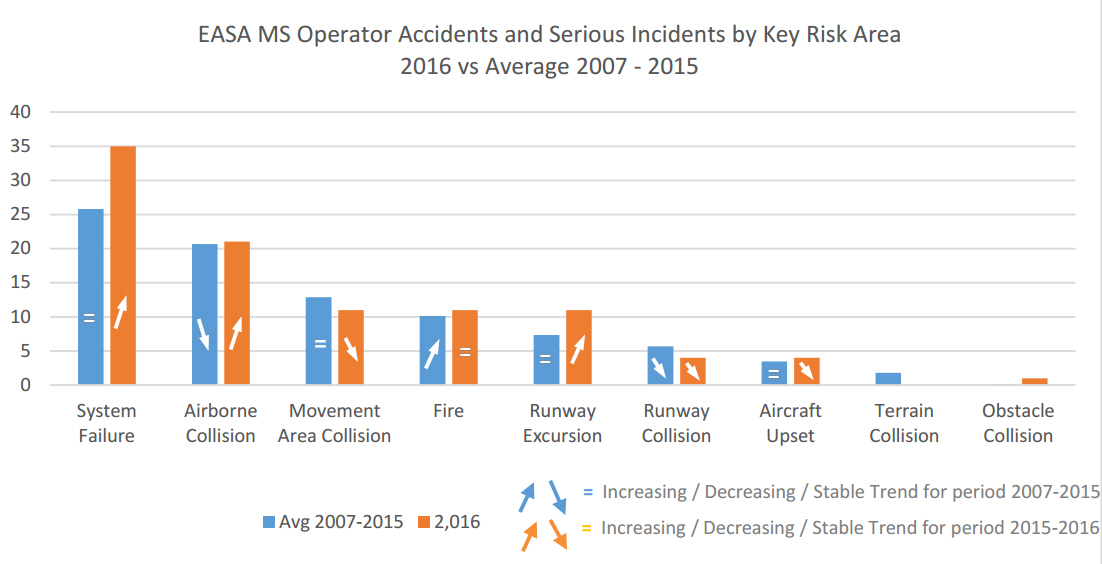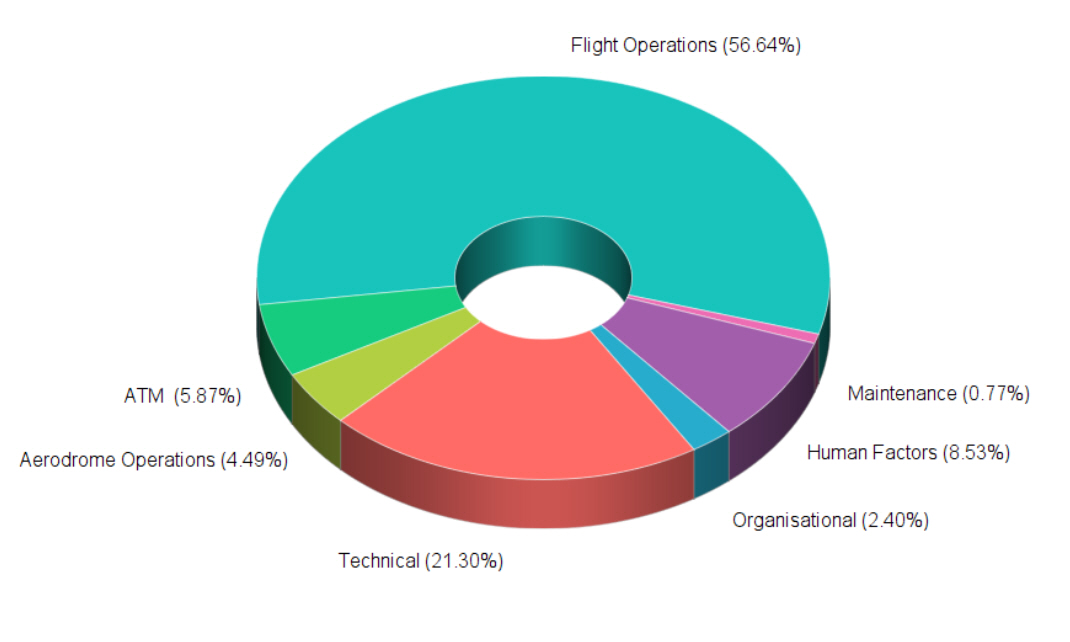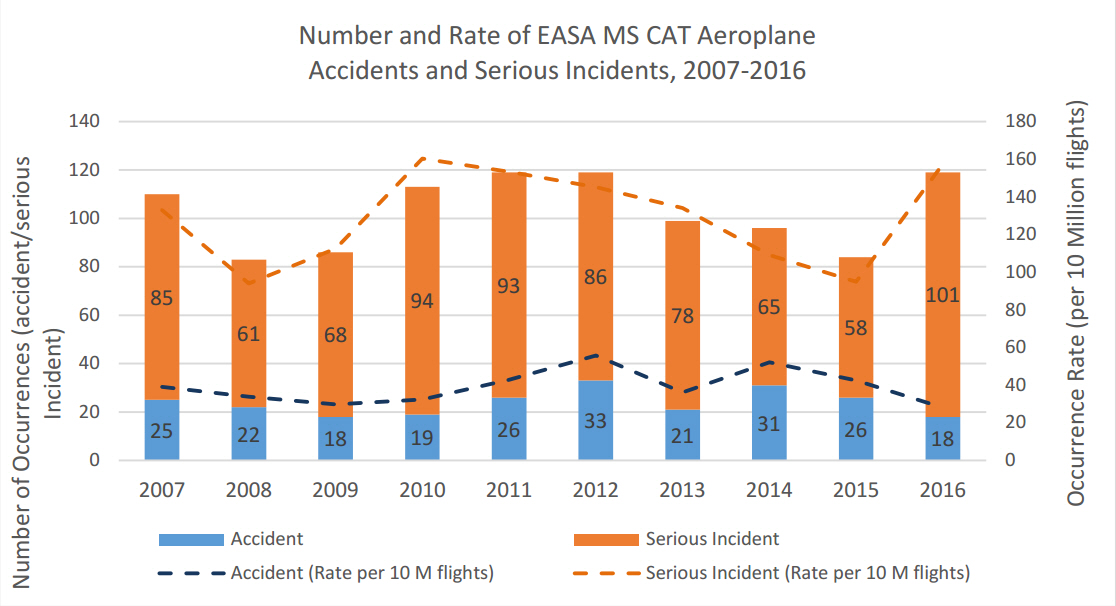Despite 2016 proving to be the safest year ever in terms of the number of fatal accidents involving large commercial aircraft, the 2017 Preliminary Safety Review published this week by the European Aviation Safety Agency (EASA) highlights a sizable 2016 increase in the number of serious incidents involving aircraft operated by carriers from the 32 EASA member states.
The EASA report notes that in 2016 there were only eight fatal accidents and 255 fatalities worldwide involving large commercial air transport (CAT) aircraft, which EASA defines as aircraft with take-off weights greater than 5,700kg (12,566lb). Two of the eight 2016 accidents occurred on cargo flights, the other six occurring on passenger flights. EASA member-state operators only accounted for one fatal CAT accident in 2016, the crash of a Bombardier CRJ200 operating a cargo flight in Sweden on 8 January which killed the two pilots flying the aircraft.
Overall, aircraft operated by EASA member-state operators were involved in only 18 accidents in 2016 compared with 26 in 2015. The 18 accidents represented a 0.0003 percent accident rate for all EASA-state CAT flights, member states’ carriers operating some 3 million flights in 2016. The EASA states’ 2016 CAT accident rate was 43 percent down – i.e., 43 percent improved – from the year before.
(ICAO’s definition of accidents includes incidents in which people are seriously injured, or in which an aircraft is damaged or suffers structural failure, or goes missing, or is completely inaccessible.)
But the number of serious incidents involving EASA-state carriers’ large commercial aircraft jumped to 101 in 2016 from 56 the year before. This increase represented a serious-incident rate of 16 per million flights, a rate 38 percent higher than that in 2015. ICAO defines a serious incident as an occurrence, other than an accident, associated with the operation of an aircraft which affects or could affect the safety of operation.
 Additionally, the 101 serious incidents represented the highest number of such incidents involving EASA member-state carriers’ aircraft in any year in the past decade. Worryingly for EASA, the 2016 number reversed a five-year declining – that is, improving – trend in both absolute annual numbers and the annual rate of serious incidents which its member states’ carriers recorded from 2010 through 2015.
Additionally, the 101 serious incidents represented the highest number of such incidents involving EASA member-state carriers’ aircraft in any year in the past decade. Worryingly for EASA, the 2016 number reversed a five-year declining – that is, improving – trend in both absolute annual numbers and the annual rate of serious incidents which its member states’ carriers recorded from 2010 through 2015.
EASA’s 2017 Preliminary Safety Review contains the caveat that “the counting of accidents and serious incidents is not a good risk measure”, and says “the introduction of the European Risk Classification Scheme in 2017 … will help to provide a better picture of the existing safety risks”. This scheme will do so by helping “to shift the focus to the probable potential harm of identified hazards to the European aviation system (risk level associated to hazards) instead of directly measuring the severity of a realized outcome (fatalities, injuries, damage)”, according to EASA.

EASA MS operator accidents and serious Incidents by key risk area 2016 vs average 2007-2015. Image: EASA
That said, the EASA report highlights some worrying trends for its member states’ carriers. Although the report notes “the number of occurrences (accidents and serious incidents) for all key risk areas, except for system failure and runway excursion, remains very similar to the average for the period 2007-2015; thus showing a stable pattern”, it then provides bad news.
“Considering the positive trend in the period 2007-2015, followed by that in the period 2015-2016, the key risk areas of system failure, airborne conflict and runway excursion show a negative change in 2016 (from stable to increasing or from decreasing to increasing),” the report declares.
EASA’s 2017 Preliminary Safety Review continues: “Aircraft Upset represents only 3 percent of the accidents and serious incidents involving an EASA member state operator in 2016. However, it continues to be the most fatal risk area for EASA member state operators. In 2016, the Preliminary Impact Assessment on “loss of control in-flight” indicated the need for specific actions in this area within the European Plan for Aviation Safety (EPAS). The EPAS is the key strategic document for improving aviation safety at [the] European Level.”
According to the report, 56.64 percent of the causal and contributory factors behind the accidents and serious incidents involving EASA member states’ carriers between 2007 and 2016 originated in the area of flight operations. Technical factors accounted for 21.3 percent of the causal and contributory factors, with human factors accounting for another 8.53 percent.
Air traffic management operations provided 5.87 percent of the causal and contributory factors and 4.49 percent resulted from aerodrome operations. Organizational factors accounted for 2.4 percent of the total and maintenance activities 0.77 percent.
Related Articles:












